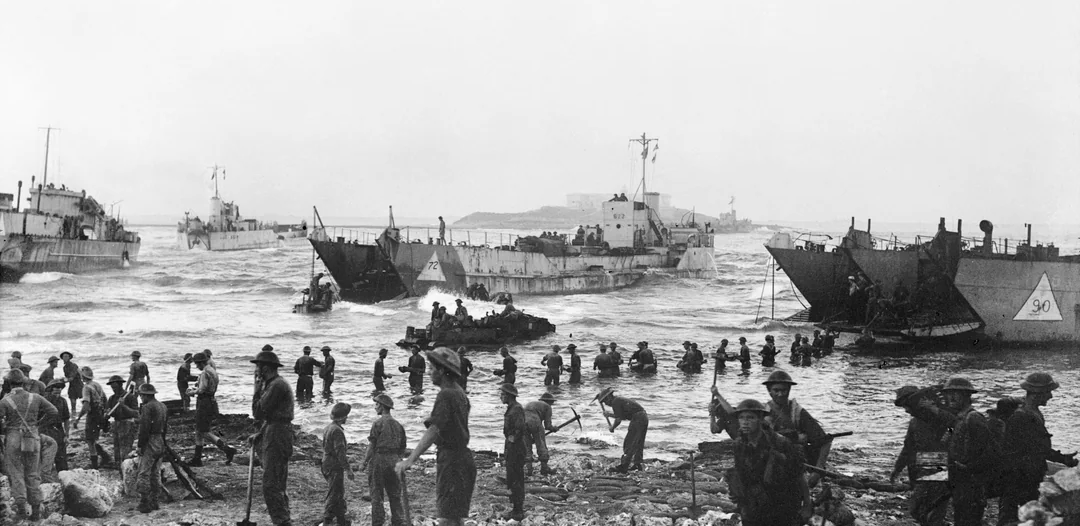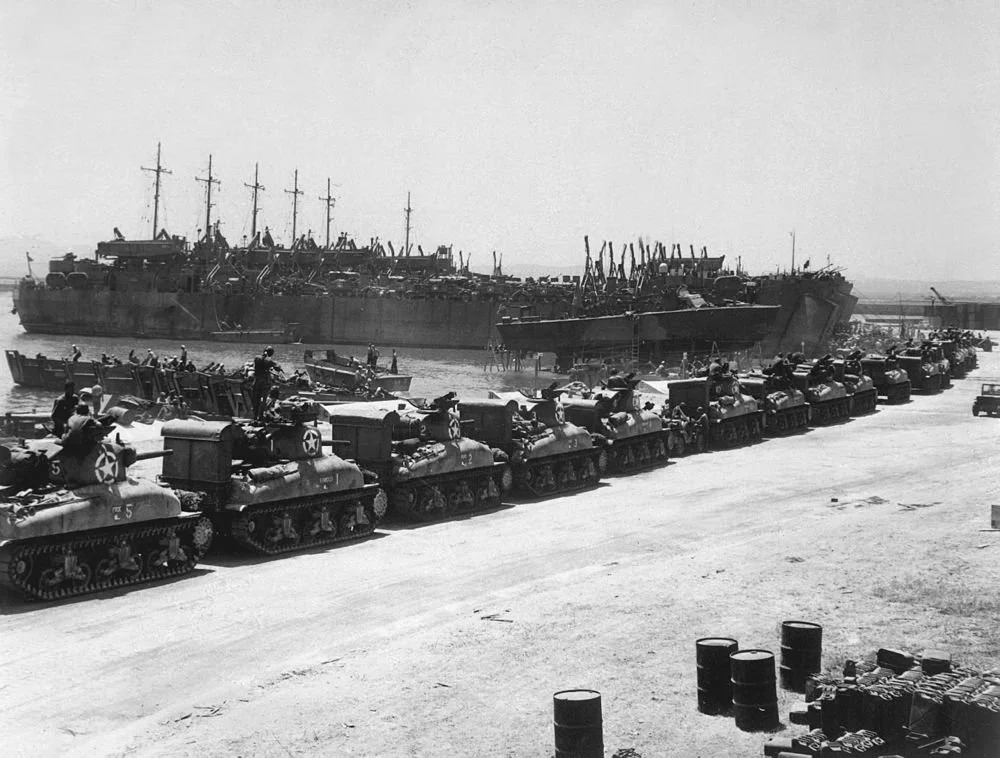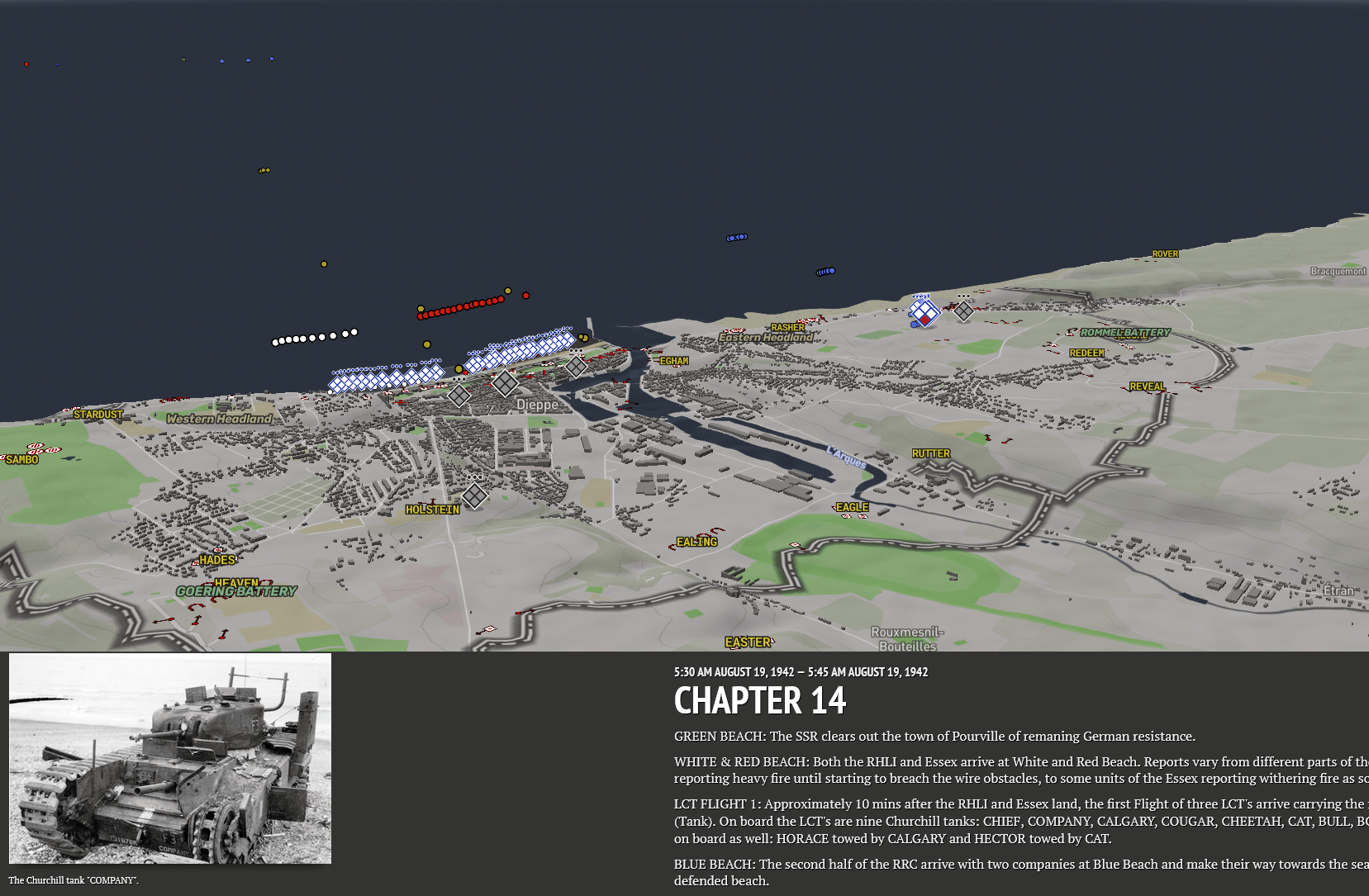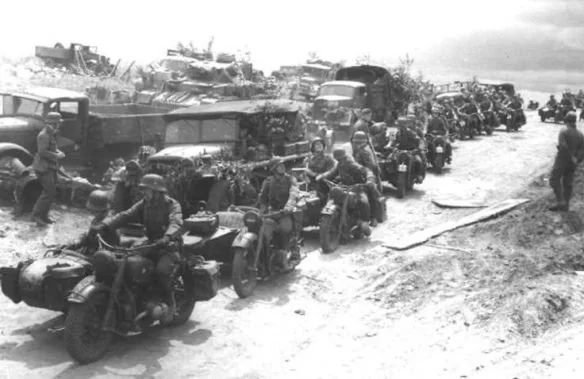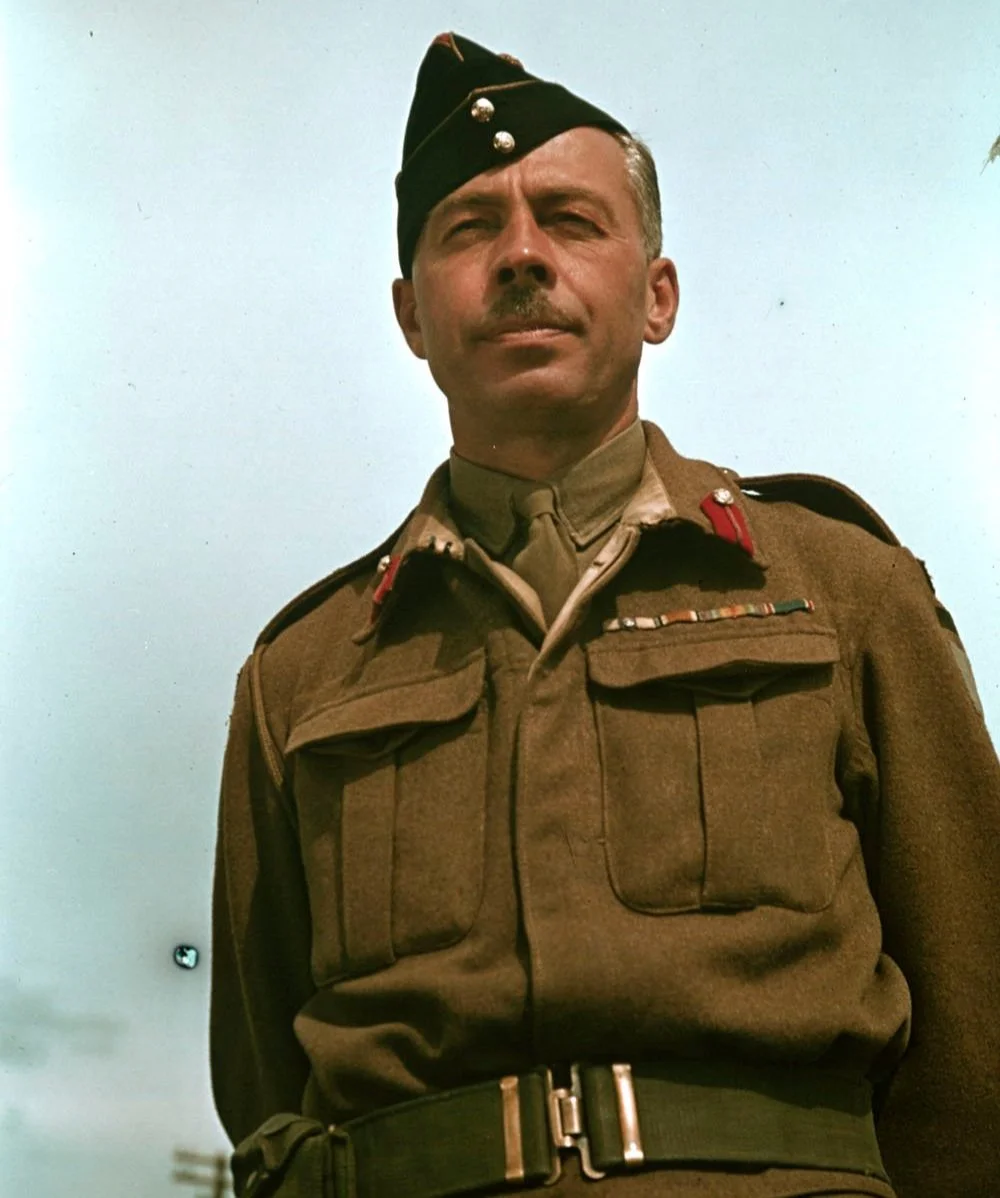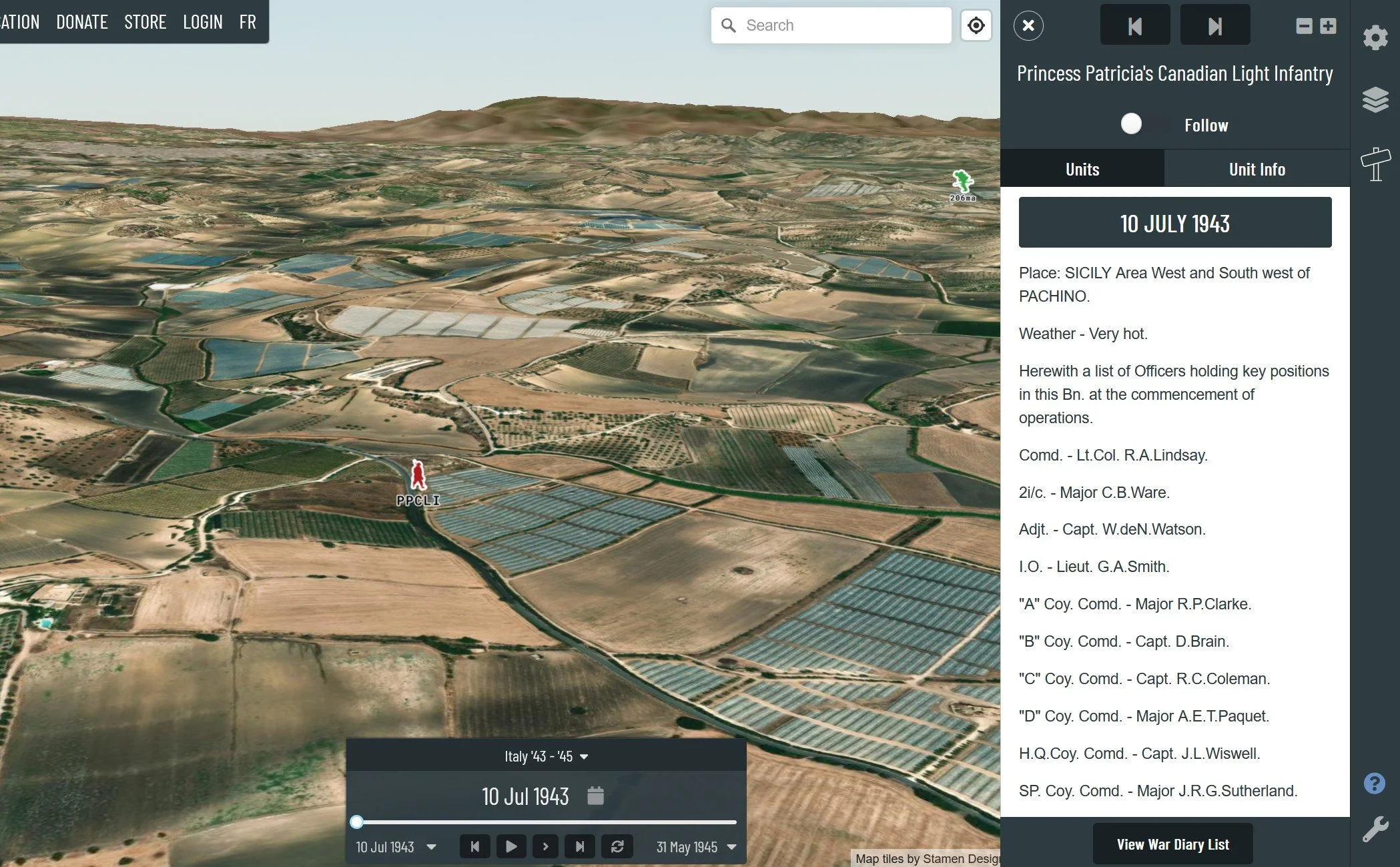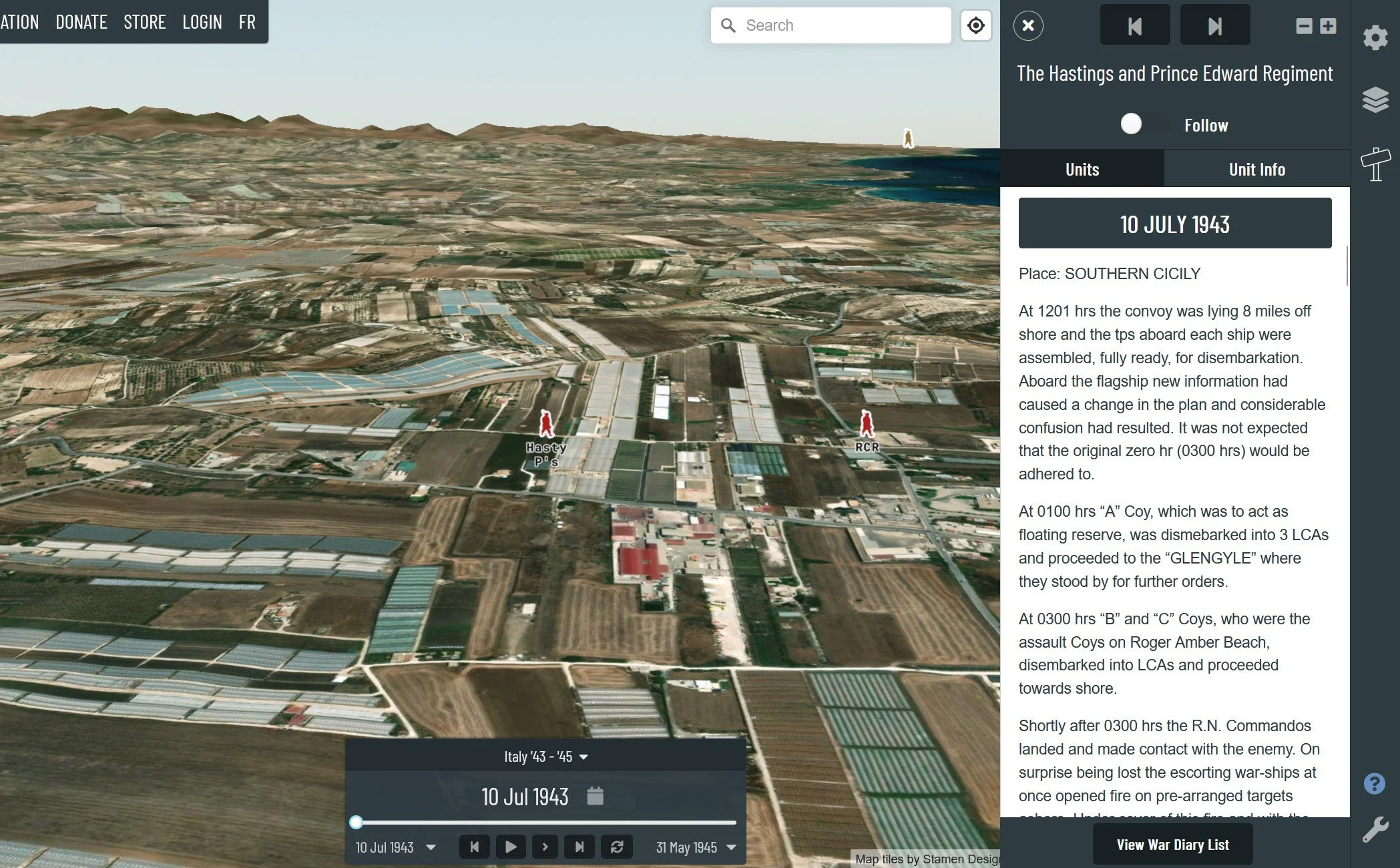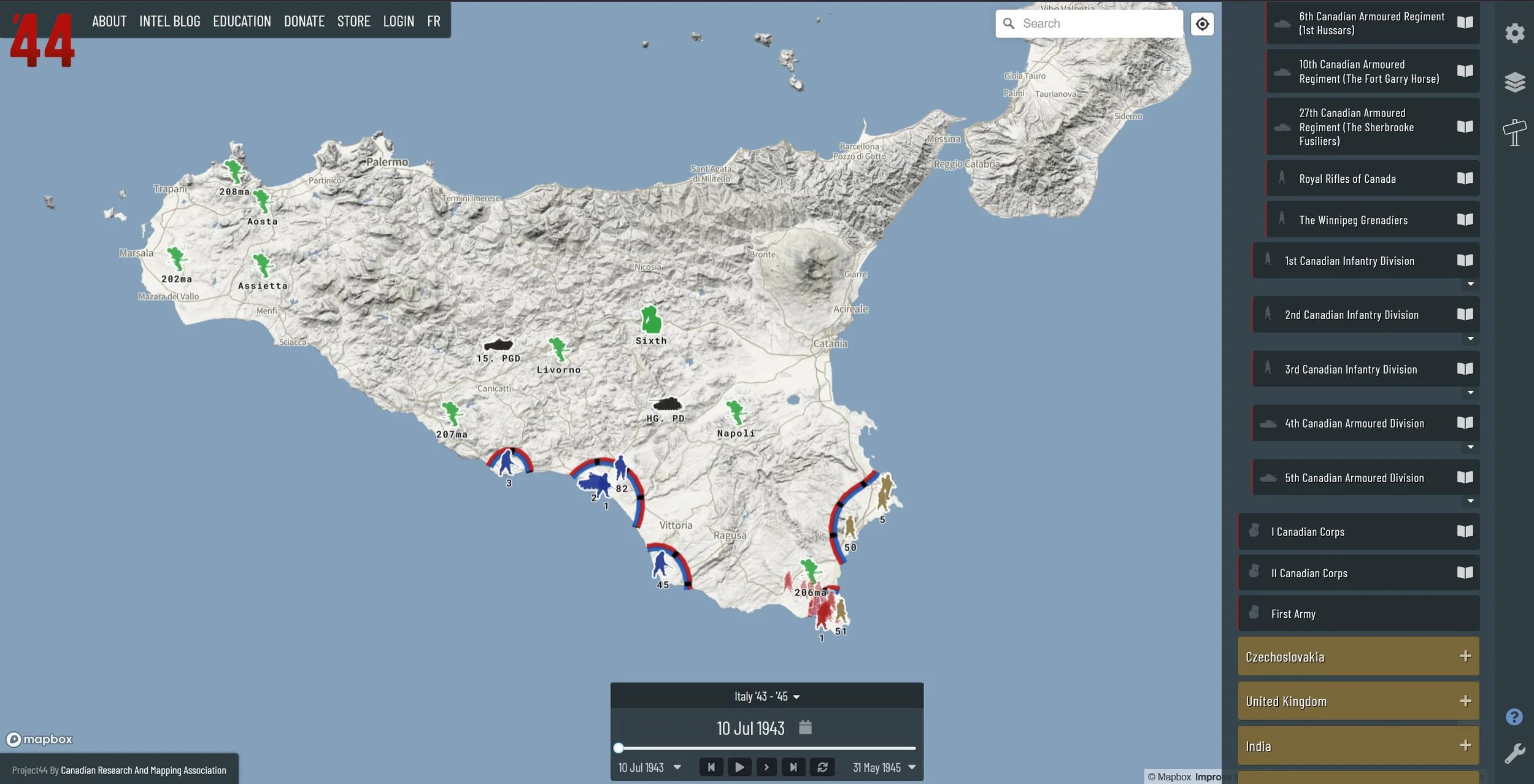Operation Husky - Invasion of Sicily
Operation Husky - Invasion of Sicily
The Allied Plan
Operation Husky, launched on 10 July 1943, was one of the largest amphibious operations of the Second World War. Its objective was clear: seize and hold the island of Sicily as a stepping stone into mainland Italy.
The Allied assault was a two-army operation involving American and British-led forces:
United States Seventh Army – General George S. Patton
Landing in the Gulf of Gela, Patton’s force included:
2nd U.S. Corps:
1st Infantry Division and 45th Infantry Division were to land near Gela, capture the town, and secure the Comiso airfields.
The 3rd Infantry Division, reinforced by elements of the 2nd Armored Division, would land further west to seize Licata and its airfield.
82nd Airborne Division: Paratroopers dropped inland near the Ponte Olivo airfield the night before D-Day to support the beach landings.
The 45th Division on Patton’s right was expected to link up with the British Eighth Army near Ragusa.
British Eighth Army – General Bernard Montgomery
Montgomery's plan involved five simultaneous pre-dawn landings along Sicily’s southeastern tip, divided between two corps:
XIII Corps (Lt.-Gen. Miles Dempsey) landed north of Cape Passero:
5th Division advanced on Cassibile and Syracuse.
50th (Northumbrian) Division took Avola to secure the flank.
The assault was supported by glider troops of the 1st Airborne Division and Royal Marine Commandos targeting coastal batteries near Syracuse.
XXX Corps (Lt.-Gen. Oliver Leese) landed farther south:
The 51st (Highland) Division landed at “Bark South” to take Pachino.
The 231st Infantry Brigade (Malta Brigade) landed at “Bark East” to link up with XIII Corps.
The 1st Canadian Infantry Division, under Major-General Guy Simonds, landed at “Bark West” to seize the Pachino airfield and advance inland.
Supporting the Canadians on their western flank was Brigadier R.E. Laycock’s Special Service Brigade, made up of Nos. 40 and 41 Royal Marine Commandos.
Together, these landings opened a 150-kilometre front along the Sicilian coast, setting the stage for the Allied advance through the island and into mainland Europe.
Waiting to Load Tanks in La Pècherie French base in French Tunisia.
Why did the Allies decide to invade Sicily?
The decision to invade Sicily in July 1943 wasn’t straightforward—it emerged from intense debate among Allied leaders following their successful North African campaign. With the Axis pushed out of Tunisia, the question became: where next?
The Great Debate: Europe or the Mediterranean?
Winston Churchill, ever the strategist, pushed for an invasion of southern Europe via the Mediterranean. He called it the “soft underbelly of Europe”—a way to knock Italy out of the war, stretch German resources, and gain easier access to central Europe.
Franklin D. Roosevelt, while more open to direct action in France, eventually sided with Churchill—especially with Stalin demanding a second front to relieve pressure on the Eastern Front. The Soviets were locked in brutal combat against Germany, and Western delay in opening another front risked political fallout with Moscow.
Why Not France in 1943?
An immediate landing in France (what would eventually become D-Day) was deemed too risky in 1943. The Allies lacked:
Sufficient landing craft and naval resources
Air superiority over Western Europe
A reliable logistical network for large-scale operations
There were also concerns about confronting heavily fortified German positions in France before the Allies were fully prepared.
Sicily: A Compromise with Strategic Value
Invading Sicily offered multiple advantages:
It allowed the Allies to maintain momentum after North Africa.
It opened the central Mediterranean for shipping.
It threatened Italy directly, leading to Mussolini’s eventual downfall.
It drew German divisions away from the Eastern Front and France.
Sicily also gave Allied forces invaluable experience in large-scale amphibious operations which would be a critical stepping stone for future landings in Italy and, eventually, Normandy.
Was Husky the first amphibious assault by Canada?
While Operation Husky was Canada’s first large-scale amphibious invasion, it was not the first time Canadian forces stormed an enemy shoreline. That distinction belongs to the Dieppe Raid in 1942. Though the lessons from Dieppe came at a high cost, they informed later operations like Husky and Normandy.
Explore our web map of Operation Jubilee, and see where Canadian units fought, fell, and forged history.
Help Us Preserve Canada's Military Story
We rely on public support to preserve and share Canada’s military history. Every map, diary, and data point is made possible by people like you. If you value this work, consider contributing to help us expand and sustain it.
Enemy Forces Opposing the Invasion
German troops of the Hermann Göring Division. Sicily 1943.
The defence of Sicily was led by the Italian 6th Army, reinforced by German formations under XIV Panzer Corps.
Italian Forces:
Two Army Corps with four regular infantry divisions:
o Aosta, Assietta, Livorno, and Napoli Divisions
Four static coastal divisions (designed primarily for defensive roles):
o 202nd, 206th, 207th, and 208th Coastal Divisions
German Forces:
o 15th Panzer Grenadier Division
o Hermann Göring Division
These Axis forces, though numerically significant, varied greatly in quality—many Italian units were poorly equipped and undermanned, while German units, particularly the Hermann Göring Division, provided experienced and mobile resistance.
Canadian Order of Battle for 10 July
Men of 2nd Seaforth Highlanders embarking onto landing craft at Sousse en route for Sicily, 5 July 1943
For Canada specifically the following units landed as part of 1st Canadian Infantry Division on the 10th of July 1943:
1st Canadian Infantry Brigade
· The Royal Canadian Regiment
· The Hastings and Prince Edward Regiment
· 48th Highlanders of Canada
2nd Canadian Infantry Brigade
· Princess Patricia’s Canadian Light Infantry
· Seaforth Highlanders of Canada
· The Loyal Edmonton Regiment
3rd Canadian Infantry Brigade
· Royal 22nd Regiment
· The Carleton and York Regiment
· The West Nova Scotia Regiment
Engineering Support
· 1st Field Company, RCE
· 4th Field Company RCE
Armoured Support
· 12th Canadian Armoured Regiment (Three Rivers Regiment)
Setbacks Before the Storm: Two Tragic Blows to the Canadian Force
Major-General G.G. Salmon
In the days leading up to Operation Husky, the Canadian contingent suffered two major losses - one in leadership and one in logistics. Though the landings would ultimately succeed, these events cast a shadow over the operation before a single boot touched Sicilian soil.
The Death of General Salmon
On July 2, 1943, Major-General G.G. Salmon, commander-designate of the 1st Canadian Infantry Division for the Sicily campaign, was tragically killed when his Hudson aircraft crashed near Barnstaple, Devonshire, shortly after takeoff from Hendon Airfield. Also on board were several senior officers, including Rear-Admiral P.J. Mack, the Canadian naval force commander, and Lt.-Col. C.J. Finlay, the newly appointed senior logistics officer for the division. All were killed.
General Salmon had been hand-picked to lead Canada’s first major amphibious campaign. His death, just days before the invasion, shook the command structure. With no time to replace him formally, Major-General Guy Simonds was appointed in his place. Simonds was known for his drive, discipline, and tactical focus. The loss of Salmon meant an abrupt shift in leadership style and planning assumptions on the eve of battle.
Sinking of Canadian Troop Ships
Only days later, Canadian forces suffered another blow. Between 4–5 July, as convoys moved across the Mediterranean from North Africa toward Sicily, Axis submarines attacked Allied shipping near the Algerian coast. Three ships were torpedoed: the St. Essylt, City of Venice, and Devis.
While the first two sinkings resulted in relatively few casualties, the loss of the Devis was severe. Carrying 261 Canadian troops, the ship was hit and engulfed in fire. Fifty-two Canadians were killed, with many trapped in the holds below deck. In total, the convoy lost over 500 vehicles and 40 guns, along with critical headquarters and signals equipment. Divisional Headquarters suffered particularly heavy equipment losses, forcing last-minute improvisation in communications and command coordination.
Despite these losses, the Canadian Division adapted quickly, and the operation went forward as planned. These early setbacks, however, underscore the high cost and uncertainty of even reaching the battlefield in the Second World War.
Join the Mission
Help us bring Canada’s military past to life. Share this post, support our efforts, or get involved with our projects. Whether through donations, research, or spreading the word, you can make a difference.
Canadian Beaches
On 10 July 1943, the 1st Canadian Infantry Division landed in southeastern Sicily as part of Operation Husky - the Allied invasion of Europe’s “soft underbelly.” The division's assault was split across two main beaches: “Roger” Beach to the east and “Sugar” Beach to the west of the village of Le Grotticelle. These beaches formed the right flank of the British Eighth Army’s landings.
General Simonds’ plan for the Canadians was a two-brigade front:
The 1st Canadian Infantry Brigade would land on Roger Beach and push inland to destroy a coastal battery near Maucini, seize the Pachino airfield, and establish contact with nearby British forces around Pachino town.
The 2nd Canadian Infantry Brigade would land on Sugar Beach, clear beach defences, support the adjacent British Special Service Brigade landing on the far left, and advance north past the Pantano Longarini marshes.
The Special Service Brigade (British Commandos) would land west of Punta Castellazzo, eliminate enemy resistance in their zone, and cover the Canadians' western flank from elevated ground north of the marshes.
The landings were scheduled for 2:45 a.m., with Commandos hitting the shore ten minutes earlier. Objectives were clear: knock out coastal defences, secure strategic positions, and quickly link up with Allied forces to expand the beachhead.
The Landings
Despite rough seas from a storm the day before, the landings went ahead as planned in the early hours of 10 July 1943. Just after 1:00 a.m., British Commandos began landing west of the Canadian sector, encountering only light resistance. By 1:34 a.m., the 2nd Canadian Infantry Brigade - the Seaforth Highlanders of Canada and Princess Patricia’s Canadian Light Infantry - were heading for Sugar Beach under covering fire from naval guns, including the 15-inch guns of HMS Roberts.
Navigation errors caused the Seaforth Highlanders to land to the right of the Patricias, reversing their intended order. But the heavy surf helped carry landing craft over a false beach, and both units came ashore with minimal opposition. They quickly cleared light beach obstacles and scattered Italian machine-gun posts. By 3:00 a.m., both battalions had successfully landed and were advancing inland toward their objectives.
On Roger Beach, however, the 1st Canadian Infantry Brigade faced delays. Their assault relied on DUKWs and landing craft (LCTs) arriving from Malta. When these were delayed, Brigadier Howard Graham initiated a backup plan, switching to Landing Craft Assault (LCAs). Confusion and the heavy swell caused further delay, with some units landing as late as 5:30 a.m. - nearly three hours behind schedule.
Despite the setbacks, the Hastings and Prince Edward Regiment and the Royal Canadian Regiment landed successfully. The Hastings had one reserve company land 5,000 yards off target in the Commando sector but regrouped without major issue. Both units met minimal resistance. The RCR encountered light shelling from the Maucini battery, but naval gunfire quickly silenced it.
By 6:45 a.m., all three lead brigades had secured their assigned beachheads, with support units and armour - including Shermans from the Three Rivers Regiment - beginning to land. The 48th Highlanders of Canada and The Edmonton Regiment followed their respective brigades ashore, some accompanied by pipe bands.
Opposition during the landings was light overall. Many Italian defenders withdrew as the naval bombardment and confusion of the assault overwhelmed them. However, isolated machine-gun fire and limited artillery shelling still resulted in several Canadian casualties, primarily on Roger Beach.
End of the first day
Following the successful landings on 10 July 1943, Canadian units rapidly moved to achieve their inland objectives. The Royal Canadian Regiment (RCR) advanced toward the Maucini gun battery and Pachino airfield. At Maucini, a single warning shot led to the surrender of over 35 Italian soldiers. The RCR pushed onward to the airfield, reaching it by 9:00 a.m. to find it ploughed up and abandoned.
Despite its damaged condition, Engineers - specifically the British 15th Airfield Construction Group under Canadian command - had a landing strip operational by midday. The RCR’s “C” Company linked up with the 51st (Highland) Division near Pachino, while “A” Company helped clear barracks and silenced a second battery north of the town. That position surrendered after stiff machine-gun resistance, with 130 Italians and four 6-inch guns captured. Acts of bravery during this assault earned Canada its first gallantry awards in Sicily.
The Hastings and Prince Edward Regiment secured their objectives east of the RCR with minimal resistance, digging in to defend the airfield. Meanwhile, west of the landings, the 2nd Canadian Infantry Brigade reached its positions north and west of the Pantano Longarini, capturing scattered Italian prisoners along the way.
Of note, the Seaforth Highlanders of Canada made the deepest Canadian advance on D-Day. According to our web map data, their lead elements pushed an impressive 16 kilometres inland, reaching the southern approaches to Ispica by nightfall. This distance made them the furthest advanced Allied unit on that flank, demonstrating both momentum and effective leadership under Lt.-Col. Hoffmeister.
The only notable enemy counter-attack occurred on the division’s far left. A determined Blackshirt unit pinned down British Commandos with mortar and anti-tank fire. A Canadian mortar detachment from the Saskatoon Light Infantry responded with 160 rounds, breaking the assault. The enemy retreated in disarray, leaving behind artillery, animals, and ammunition.
That evening, the 3rd Canadian Infantry Brigade pushed inland alongside the 2nd Brigade, reaching forward positions near Ispica. The West Nova Scotia Regiment engaged in its first firefight and captured 25 Italians without suffering casualties.
By the end of D-Day, Canadian objectives were firmly in hand. Over 650 prisoners had been taken, with minimal Canadian losses - 7 killed, 25 wounded. The first day of Operation Husky for the Canadians had been a clear tactical success, paving the way for the next phase of the Sicilian campaign.
Take History Home
Explore the battlefield through our detailed historical maps that are available in print. Every purchase supports our mission and helps fund future mapping projects. Visit our store to browse Canadian campaigns, including Operation Husky and more.
Take History Home
Explore the battlefield through our detailed historical maps that are available in print. Every purchase supports our mission and helps fund future mapping projects. Visit our store to browse Canadian campaigns, including Operation Husky and more.
Prominent war diary entries
12th Canadian Armoured Regiment (Three Rivers Regiment)
Place: Pachino Peninsula, SICILY
Weather Clear and warm with no Wind.
Web map showing the Three Rivers Regiment with modern satellite imagery.
0245 The first Assault troops landed under fairly heavy fire and fought their way onto the shore establishing a bridgehead which more consolidated as time went on and more troops reached and joined forces with those fighting on the beach. During the morning they continued to land and the operations went along successfully with the Monitors assisting to silence shore batteries.
0900 The first tanks went off the LST at point 929886 (sheet 277), in approximately six feet of water and about 180 feet from shore.
1015 All tanks from LST 321 arrived at the de-waterproofing area. The C.Os. and Recovery tanks remained on the beach to direct the landing of the remainder of the Regiment. At this time General Simmons, who was on the beach, asked Lt-Col Booth how soon the 12th Canadian Tank Regiment would be ready for action. Col. Booth told him that "C" Squadron was available immediately.
1530 All tanks from LST 391 arrived in de-waterproofing area, along with the tanks from CC 12. The C.O., Lt-Col. E.L. Booth ordered one squadron of tanks to assist the Carleton and York Regiment, of No. 1 Cdn Infantry Bde, in their drive on the high ground at Area 935915, known as Burgio.
1800 R.H.Q. and “C” Squadron arrived at the harbour area in Sq. 9290 (Sheet 273-111). Ships in the harbour were being bombed by high-level bombers. There was also heavy bombing to the West of the harbour. This was kept up most of the night and heavy A/A fire was returned. One of the hospital ships was hit but none of the patients was lost. The noise from the A/A and bombs was terrific and shrapnel from exploding A/A was extremely dangerous and was the cause of many men being wounded. Due to the shallow nature of the beach many LSTs. were unable to get close enough to shore to permit disembarkation of vehicles and some tanks, all A & B vehicles and personnel remained on board throughout the night.
Princess Patricia's Canadian Light Infantry
Place: SICILY Area West and South west of PACHINO.
Web map showing the PPCLI with modern satellite imagery.
Weather - Very hot.
Herewith a list of Officers holding key positions in this Bn. at the commencement of operations.
Comd. - Lt.Col. R.A.Lindsay.
2i/c. - Major C.B.Ware.
Adjt. - Capt. W.deN.Watson.
I.O. - Lieut. G.A.Smith.
"A" Coy. Comd. - Major R.P.Clarke.
"B" Coy. Comd. - Capt. D.Brain.
"C" Coy. Comd. - Capt. R.C.Coleman.
"D" Coy. Comd. - Major A.E.T.Paquet.
H.Q.Coy. Comd. - Capt. J.L.Wiswell.
SP. Coy. Comd. - Major J.R.G.Sutherland.
M.O. - Capt. G.C.Fairfield.
Paymaster. - Capt. J.A.McLeod.
Chaplain - Capt. M.J.D.Carson.
There were no enemy to hinder our huge armada as it neared the coast of SICILY, but flares and flackwere visible as our heavy bombers pounded PACHINO. Serials stood by in their mess decks at 2345 hrs, 9 Jul. and at approx. 0100 hrs, first flights were lowered to commence the rough 7 mile trip to SUGAR GREEN BEACH.
The landing was made with "B" and "D" Coys in the assault. Complete surprise was effected. A certain amount of M.G. firing on fixed lines was encountered and also some heavy wire. Serials made up from Bn.H.Q., "A" and "C" Coys followed the assaulting troops and came under heavy fire from Coastal Batteries which were silenced at 0445 hrs by Navy guns.
Due to the heavy swell, some serials became scattered and a certain amount of confusion resulted, as timing was put out, and some landed at wrong places. However the Bn. was soon able to reorganize and pushed forward from the initial beach-head positions to occupy the ground planned as the first Phase of the invasion. At approx. 1000 hrs the 1st Phase was completed and the Bn. consolidated with the Coys taking up positions previously allotted in the planning.
Patrols were sent out and several minor clashes took place, with few casualties. Many Italian prisoners were taken without their offering any fight, and these were soon cleared back to the beach where a P.W. Cage had been established. The natives were very friendly and appeared happy to have their country invaded by the Allied Forces.
At 2130 hrs the Bde. Gp. commenced to advance from the 1st Phase positions to occupy those of the 2nd Phase. "A" Coy acting as advance guard to the Bn, came under came under fire just short of it's objective. An attack was put in and resulted in the surrender of the enemy and the capture of 4 Italian guns intact. During this advance the sky was aglow with flak and tracer as enemy planes carried out an attack on our ships which were still unloading on the beaches.
The 2nd Phase positions were occupied, and after consolidation and digging-in the troops were able to get something to eat and some rest. In these early stages success came easily and swiftly, and all were warned against any relaxation of the small points that make for the success of an operation.
Casualties in the Bn were very light, but for the enemy quite heavy in comparison. Lieut. G.S.Lynch was at first believed to have been taken prisoner, but though badly wounded, managed to make his way back to his Pl. H.Q. after the enemy had left him for dead, and was evacuated to the beach Dressing Station.
Map showing Beaches, Beach defenses, and route taken by this Bn.
Trace showing 1st and 2nd Phases Of Exercise "HUSKY" .
THE INITIAL LANDING IN SICILY.
The Hastings and Prince Edward Regiment
Place: SOUTHERN CICILY
Web map showing The Hastings and Prince Edward Regiment with modern satellite imagery.
At 1201 hrs the convoy was lying 8 miles off shore and the tps aboard each ship were assembled, fully ready, for disembarkation. Aboard the flagship new information had caused a change in the plan and considerable confusion had resulted. It was not expected that the original zero hr (0300 hrs) would be adhered to.
At 0100 hrs “A” Coy, which was to act as floating reserve, was dismebarked into 3 LCAs and proceeded to the “GLENGYLE” where they stood by for further orders.
At 0300 hrs “B” and “C” Coys, who were the assault Coys on Roger Amber Beach, disembarked into LCAs and proceeded towards shore.
Shortly after 0300 hrs the R.N. Commandos landed and made contact with the enemy. On surprise being lost the escorting war-ships at once opened fire on pre-arranged targets ashore. Under cover of this fire and with the support of LCS vessels “A”, "B" and "C" Coys made their landings touching down on the beach shortly before dawn.
“A” Coy was landed in the face of fairly heavy M.M.G. fire on Sugar Beach, some 5000 yds to the left of its proper beach. On landing, wire obstacles were encountered which were demolished by bangalore parties and the Coy crossed through the gaps made and took up posns on the dunes. Eight and nine Pls at once became fire gp while seven Pl carried out a left flank attack on the enemy M.G. posn. In conjunction with a party of commandos who attacked from the rear, the posn was taken. Some 20 German and Italian prisoners, together with 4 MMGs were captured.
"B" Coy made an unapposed landing on Roger Green Beach instead of on Amber as planned. Some wire obstacles were encountered and blown. The only enemy in this area were one or two snipers who were killed.
“C” Coy had an un e ventful approach and made an unopposed landing a mile to the East of their correct beach. Minor wire obstacles were encountered and blown allowing the Coy to penetrate inland and consolidate on the dunes.
“D” Coy and Bn H.Q. made their landings in full daylight with that part of Bn H.Q. and 1 Pl of "D" Coy, which was in an L.C.M., landing on the beach which "A" Coy had captured, while the remainder of "D" Coy and balance of Bn H.Q., who were in L.C.A.s were the only people to land on their correct beach, carrying this out under the leadership of Major A.A. Kennedy, who took over the navigation during the approach. No opposition was encountered on the beaches by these tps.
The move inland to the Bn objective was not fully complete until the arrival of "A" Coy at 1600 hrs. Both "D" and “A” Coys encountered enemy enroute. "A" Coy meeting and capturing an Italian Fd gun and Tractor together with seven prisoners. "D" Coy encountered a fortified hill two miles inland and was successful in capturing the posn which was held by three M.M.G.s and two 75mm Fd guns. The Bn, by 1800 hrs, estd in a defensive posn covering the PACHINO Airfield and with the RCR on the right. With the exception of enemy air raids on the beaches no further activity took place during the night.
Visit our web map to discover more!
Make sure to visit our web map and follow along any of the Canadian units day by day and read their full war diaries!
All you need to do is click the link below and go to the web map.
Make sure you click the Italian campaign on the time slider to go to the right place and time!

